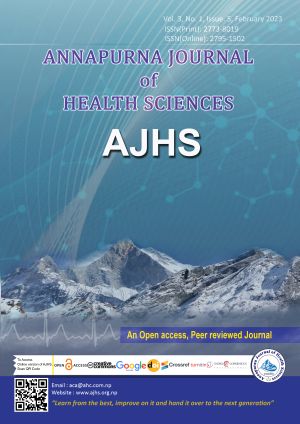Association of Premenstrual Syndrome with Body Mass Index among Young Female Adults in a Dental College of Kathmandu
Keywords:
Body mass index, Premenstrual Syndrome, Young AdultsAbstract
Introduction: Premenstrual syndrome (PMS) is a cyclical symptom affecting female during the luteal phase of menstrual cycle. Body mass index (BMI) plays an important role in reproductive health of women. This study aims to see the prevalence of PMS and its association with BMI among the participants.
Methods: This cross sectional study among 239 female undergraduate dental students was conducted in Kantipur Dental College Teaching Hospital and Research Centre from February to June 2020 with convenience sampling. The participants between 18-26 years of age without endocrine, psychological or gynecological disorders were given a self rated questionnaire based on Pre-Menstrual Symptom screening tool to fill. The height and weight of the participants were measured in the standardized way. The data was analyzed using SPSS-16 software.
Results: The prevalence of moderate to severe PMS was 39% and mild to none PMS was 61%. The participants with moderate to severe PMS were more in BMI II category (42.6%) followed by BMI III (35.7%). The most prevalent changes seen among participants in moderate to severe PMS were interferences in relationship with co-workers (167) and interference with family (141). The mean weight, height and BMI of the participants with moderate to severe PMS were 51.48±6.61kg, 154.80±6.52 cm and 21.39±2.43 kg/m2 and the mean comparison of BMI between mild to none PMS and moderate to severe PMS category was found to be statistically insignificant (P=0.95).
Conclusion: The premenstrual syndrome mostly associated with interferences in daily activities was prevalent among the undergraduate dental students of Nepal. The development of premenstrual syndrome had no association with body mass index of the participants in this study.
Downloads
Downloads
Published
How to Cite
Issue
Section
License
Copyright (c) 2023 Sonam Chaudhary, Prashanna Shrestha, Mahesh M. Bajimaya, Sait Pradhan, Narayan Mahotra

This work is licensed under a Creative Commons Attribution 4.0 International License.
This license allows reusers to distribute, remix, adapt, and build upon the material in any medium or format, so long as attribution is given to the creator. The license allows for commercial use.




